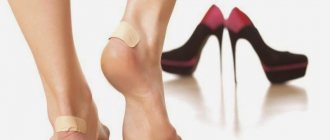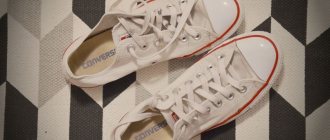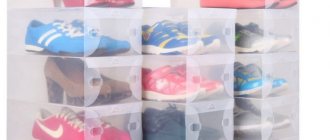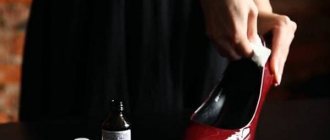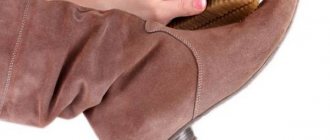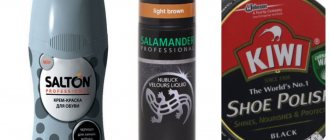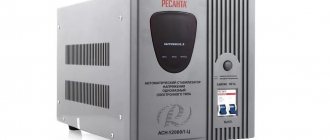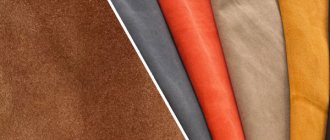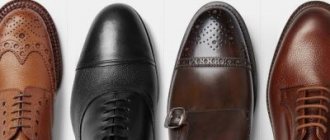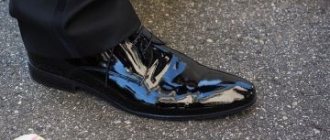How often, having put on a new pair of shoes in the morning with pleasure and joy, in the evening we return with swollen and exhausted feet with calluses and scuffs! All the joy from beautiful shoes turns out to be spoiled for a long time, since chafed feet will have to be treated for a long time, and you will have to walk in old, soft and comfortable shoes, almost in slippers.
What should you do to rid yourself of problems with chafing and wear your favorite shoes with pleasure, not pain? There are several simple ways to deal with this situation.
How to break in tight shoes
Don't wear new shoes to an important event.
Are you going to a party, visiting or going for a walk and you have new shoes? Have mercy on your feet and don’t spoil your holiday. If the shoes do not pinch anywhere when trying them on, this does not mean that during wearing they will not reveal such “pleasant” features as protruding sharp parts, a heel that rubs, or decorative details that pinch the toes. To avoid such “surprises,” simply put on new shoes, sandals or boots at home and wear them for several days, at least an hour a day. This will help the product mold to the shape of your foot and will also help you locate areas where a callus or abrasion may occur. While wearing shoes at home, you will be able to find protruding threads or pieces of trim that can be carefully trimmed, find out exactly where the shoes are rubbing and whether they are true to their size.
If you find that your new pair of shoes is rubbing because they are too small, you can try breaking them in. Remember that this can only be done if the size difference is no more than half the size.
Wear your shoes on socks
To break in, you can use “grandmother’s” methods:
- Wearing new shoes with thick socks. This is the safest method in all respects. With it, it is impossible to damage an expensive pair of shoes or “torture” your feet.
- Wetting the inside of shoes with water before putting them on. This is a risky method, as it can leave permanent stains, severely deform the shape of the shoe, and cause parts and finishes to peel off. This method is good if it turns out that only some part of the shoe is in the way, for example, the side part is pressing. It is enough to moisten it a little with water and wear it for a couple of hours until the desired effect is obtained.
- Using alcohol as a dressing agent. Quite an effective, but also dangerous method. It can cause severe deformation and stretching of shoes and boots made of very thin leather, as well as the appearance of stains, especially on multi-colored, suede and textile products. Alcohol also dries out the skin and feet and can cause them to be permanently stained with shoe dye. Shoes stretched by this method can be “painted” for a long time, spoiling the hosiery.
Skin stretching spray
Note! The most correct and safe method of breaking in shoes is to use a special factory-made spray or foam to increase the size of the shoes. Such products have a proven formula and are safe for both shoes and human health.
Suede shoes
Suede and nubuck lend themselves well to stretching in the freezer. We described this method above. Simply place a sealed plastic bag filled with water in your shoes and freeze for 6-8 hours. After the ice has melted slightly, carefully remove the bag from the shoe.
For suede there is another method, more delicate. Wet the inside of your shoes thoroughly with beer , put on thick socks and walk around in your shoes for 1-2 hours. Then air the shoes outdoors. Be careful: if you overdo it, your shoes may become a size larger than you planned.
You can only process suede from the inside: otherwise, streaks or stains may remain.
How to deal with it
Ways to help deal with chafing
Shoes may be new or old, true to your size, but from time to time your feet will rub in different places. This can be caused by many reasons - swelling on a hot day or during heavy physical activity, increased sweating, dust, sand getting into shoes, structural features of the foot, inconsistency of the chosen pair and many other factors.
There are several options for action that you can take if your shoes are rubbing. All of them are designed to either reduce friction or eliminate its cause.
Textile shoes
For textiles, you can use the method using boiling water. Quickly rinse your shoes with plenty of boiling water, wait a few seconds, put on thick socks and walk around in your shoes until they dry. This method is suitable for most natural shoe materials.
Another way: stuff the shoes tightly with white paper, moisten them with warm water and dry the shoes naturally.
Do not use newspapers to stretch textile shoes or shoes with light-colored interiors: wet newspapers may leave ink marks.
Summer shoes chafe
Silicone anti-chafing strips
If your favorite summer strappy sandals rub your sensitive calluses, buy special silicone self-adhesive strips. They are glued to the straps from the inside out so that they touch the skin, preventing pressure and rubbing on the feet by the shoe material itself. This is a great way to get rid of problems with elegant shoes on hot summer days and evenings, when “steamed” feet are simply cut to blood by the straps and edges of fashionable sandals.
What remedies help?
- Liquid for stretching. To stretch leather shoes, you need to put them on and apply the spray according to the directions on the package. Wear until the spray dries. In the process, the skin will adapt to the shape of the leg.
- Shoe stretchers. Shoe stretching pads. They are suitable for both men and women. Made from real beech wood.
- Ice. Fill two bags with water and tie. Place them inside the products and put them in the freezer. When the water turns into ice, you need to take it out so that it melts. Repeat the procedure several times until the shoes reach the desired size.
Shoes rub your heel
Heel rubs
Closed shoes have another “sin” - they often rub the heel. You can get rid of this using a simple method - rub the inside of the backdrop with a candle, a piece of wax or rosin. These substances will smooth the surface of the backdrop and make it smooth and more gliding.
Sometimes the cause of heel rubbing is an unnoticeable protrusion on the heel or a rough seam. Feel the backdrop with your hands, remove any protruding threads or parts, and iron the rough seam with force using the large handle of a table knife. This will smooth out any uneven edges and make the seam flatter. Also, when rubbing the heel, dusting the inside of the feet and shoes with talcum powder, baby powder or finely ground magnesium powder helps. In addition to making shoes easier to wear, these products eliminate excessive sweat.
Note! The simplest and most effective method is to use special silicone or leather pads glued to the backdrops.
What it is?
There are two types of calluses:
- callus (appears with prolonged friction or pressure on the skin of the feet);
- callus (formed during the process of bone tissue regeneration after fractures, is a connecting “layer” that is formed at the site of a violation of the integrity of bone tissue).
Important! Of great interest to most people, of course, is callus, which forms when wearing uncomfortable shoes, having flat feet, excess weight, problems with joints, etc.
Rubs the edge of the shoes
If the edge of your shoes rubs
Sometimes it happens that everything is fine in the shoes, but one edge of it literally digs into the skin.
This usually happens at the junction of two or more parts. If you don't know what to do with such a pair, try purchasing the same silicone self-adhesive pads as special tapes for sandals. They have the shape of a small circle or oval and are attached from the inside to the place where there is a defect. Usually this is enough to make wearing shoes easier and more comfortable. To the list of news
patent leather shoes
For patent leather shoes, it is best to use vodka or alcohol diluted with water (1:2 ratio). Soak thick socks in vodka or alcohol solution, wring them out lightly, put them on and put on new patent leather shoes. Wear your shoes until your socks are dry (this process may take 2-3 hours). This method is safe for varnish; if you do everything carefully, this will not affect the appearance of the shoes in any way. The main thing is not to overdo it: if you stretch it too hard, the varnish may crack.
When wearing patent leather shoes, it is very important to prevent cracks from appearing.
To stretch patent leather shoes, you can use Vaseline, rich cream or castor oil . Lubricate those places where the shoes are too tight (inside and out), put on thick socks and walk around the house for a while. The varnish will soften and stretch.
Main reasons for inconvenience
Let's look at the question of why new shoes rub the heel or other part of the foot, and most importantly, what to do if new shoes rub, consider the options:
- Wrong size. This is the most common case when a problem arises with shoes. If the product is too small or too large for you, it will create inconveniences that will affect the skin, irritating it and rubbing huge calluses.
- Rough material of the product. If your shoes have rough heels, they will rub your heel.
- Inconvenient model. Any shoes should not only be the right size, but also fit the model. Everyone's legs are different, their feet are wide and narrow, which means that fashionable products from famous brands will not suit all legs. The choice is yours: wear an exclusive model and suffer from constant calluses or buy a comfortable pair of shoes.
- The next problem depends on the individuality of your body - swelling of the legs. When buying shoes, we sometimes forget that when walking for a long time, our feet swell and become larger. This leads to rubbing of calluses.
Important! If you are concerned about swelling of the legs, consult a doctor; excessive swelling of the legs can be a signal of various diseases.
Universal methods
There are ways to stretch shoes that are suitable for all models, styles and materials. Gradual stretching will help maintain the integrity of the material. The appearance will not be affected if you use specialized products.
Professional products
In addition to traditional methods, you can use special sprays and foams to stretch all types of material. Professional teams will effectively cope with the task in a short time.
Mechanical devices
Special pads with a screw mechanism are available in several options. There are compact sliding models for stretching in width. Multifunctional shoe stretchers in all directions will help to widen, lengthen and increase the instep.
Use the information in this article and helpful tips to make your shoes more comfortable. Take safety precautions and test chemical formulations before applying them. Simple folk remedies will help reduce the cost of purchasing professional products and the services of a shoemaker.
If calluses appear
Unfortunately, despite all the precautions, it is not always possible to protect your foot from rubbing . You can rub a callus even with old and seemingly comfortable shoes, even with soft indoor slippers. What to do if corns or calluses appear, the skin becomes rough, red, or even begins to bleed?
The first step is to replace shoes that have caused problems after wearing them. Replacement does not mean throwing it away or taking it to the store, especially if the problem arose for the first time. It's easy enough to wear something else in the following days.
Calluses are blisters filled with whitish liquid, the so-called dropsy. Any touch to them is painful, therefore, after any medical procedures, baths and compresses, it is necessary to protect the damaged area from external influences with a plaster. For quick healing of calluses, a compress made from plantain or freshly cut aloe leaf helps. Under no circumstances should you puncture a water callus, as this can lead to infection.
Soft protectors to reduce shoe instep by 2-3 mm
- How much does the instep of shoes decrease: 2-3 mm
- How to use: Wear on the forefoot
- For which shoes: open-toe shoes
Have you seen this picture: a girl walking along the sidewalk in open-toe shoes, and her toes “slap” on the asphalt? To avoid repeating this mistake, wear these protectors with open-toed shoes. Dense silicone will fix the foot in the toe part of the shoe and will not allow the toes to “fall out” out.
To avoid repeating this mistake, wear these protectors with open-toed shoes. Dense silicone will fix the foot in the toe part of the shoe and will not allow the toes to “fall out” out.
How to treat a hard growth so that it does not exist?
If the rubbing process was long and the growth became dense and dry, then be prepared for the treatment to be delayed. It is imperative to use special softening preparations that will help remove rough layers of skin.
Salicylic acid
Salicylic acid is a standard ingredient that helps soften hard growths on the feet. It is included in many creams, ointments, gels and even patches (“Namozol”, “Kollomak”, etc.).
Before using products with salicylic acid, you should steam your feet and stick a patch with the middle cut out on the problem area (the hole should be the size of a callus). Only after this the drug can be applied to the growth. You can use acid 1-2 times a day.
Lactic acid
Important! Lactic acid is a less aggressive agent compared to salicylic acid.
Such preparations (“Green Pharmacy”, “Super Anticorn”, etc.) should be applied in a thick layer to the injury and covered with a bandage. After a couple of hours, you can remove the softened defect with a spatula, and rinse off the remaining product with water.
Treatment with celandine
A universal plant that is actively used in folk medicine. Excellent against corns and warts. You need to use a solution based on celandine twice a day, but the treatment course should not last longer than 10 days. Burn the damaged areas for 8–10 minutes, and then rinse off the product with warm water. You can also use pharmaceutical preparations based on celandine (“Call Ka”, “Stopmozol”).
Sodium hydroxide
Preparations based on sodium hydroxide are quite aggressive, and therefore they quickly corrode dead skin cells, removing calluses. Such drugs (“Antipapillom”, etc.) must be used extremely carefully so as not to harm healthy areas of the skin.
Phenol
Products containing phenol help to burn and mummify rough areas of the skin. Gradually the callus will dry out and fall off on its own.
Attention! The most commonly used drugs are “Verrukacid”, “Vartek” and others.
Refrigerants
Such drugs have only recently begun to gain popularity. They help get rid of growths in the shortest possible time. Using a special applicator, the product is applied to rough areas of the skin. A bubble with liquid forms at the site of damage. Healthy tissues remain safe and sound, but the bubble gradually dries out and falls off. This category of drugs includes “Wartner” and “Cryopharm”.
